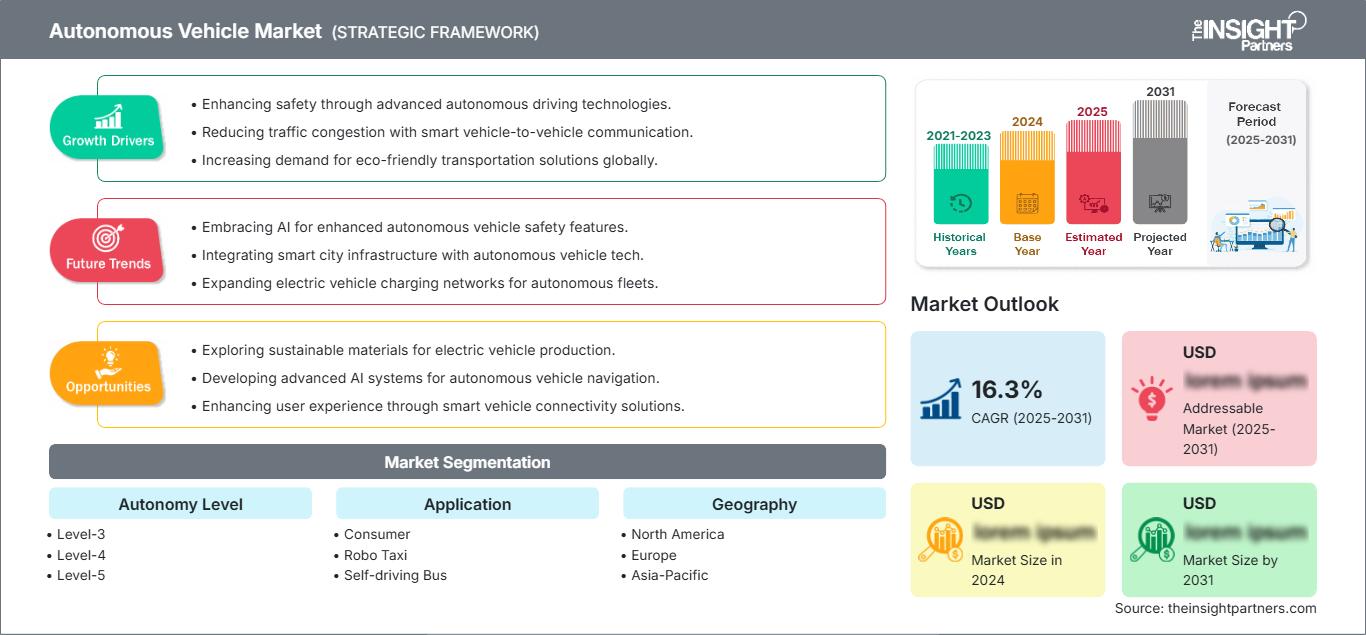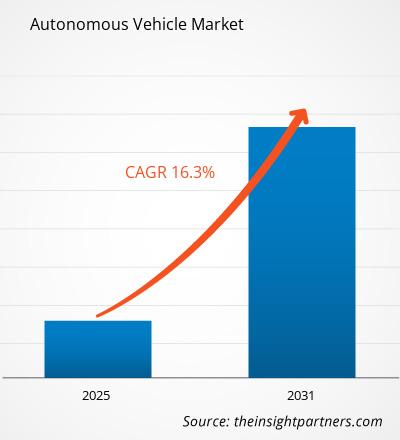自動運転車市場は、2025年から2031年にかけて年平均成長率(CAGR)16.3%を記録し、市場規模は2024年のXX百万米ドルから2031年にはXX百万米ドルに拡大すると予想されています。
本レポートは、自動運転レベル(レベル3、レベル4、レベル5)、アプリケーション(コンシューマー、ロボタクシー、自動運転バス、ライドヘイル、ライドシェア)別にセグメント化されています。グローバル分析は、地域レベルと主要国別にさらに細分化されています。本レポートでは、上記の分析とセグメントの米ドル建ての値を提供しています。
レポートの目的
The Insight Partnersによる自動運転車市場レポートは、現在の状況と将来の成長、主な推進要因、課題、および機会を説明することを目的としています。これにより、次のようなさまざまなビジネス関係者に洞察が提供されます。
- テクノロジープロバイダー/メーカー: 進化する市場のダイナミクスを理解し、潜在的な成長機会を把握して、情報に基づいた戦略的決定を下せるようにします。
- 投資家: 市場の成長率、市場の財務予測、バリューチェーン全体に存在する機会に関する包括的なトレンド分析を実施します。
- 規制機関: 乱用を最小限に抑え、投資家の信頼と信用を維持し、市場の完全性と安定性を維持することを目的として、市場におけるポリシーと警察活動を規制します。
自動運転車市場のセグメンテーション 自動運転レベル
- レベル3
- レベル4
- レベル5
アプリケーション
- 消費者
- ロボタクシー
- 自動運転バス
- ライドヘイル
- ライドシェア
レポートの一部、国レベルの分析、Excelデータパックなどを含め、スタートアップ&大学向けに特別オファーや割引もご利用いただけます(無償)
自動運転車市場: 戦略的洞察

- このレポートの主要な市場動向を入手してください。この無料サンプルには、市場動向から見積もりや予測に至るまでのデータ分析が含まれます。
自動運転車市場の成長要因
- AIと機械学習の技術進歩:AIと機械学習技術の継続的な進歩が、自動運転車(AV)市場を牽引しています。これらの進歩により、AVはセンサーからのデータをより適切に処理し、リアルタイムの意思決定を行い、安全性を向上させることができます。AIは、車両が周囲の環境をより正確に解釈することを可能にし、ナビゲーション、衝突回避、交通管理を改善します。これらの技術が進化するにつれて、自動運転車の信頼性が高まり、消費者の信頼と受容性が高まり、市場の成長が加速します。
- 道路安全と事故防止への関心の高まり:自動運転車は、交通事故の大部分の原因となっている人的ミスを削減する準備ができています。センサー、カメラ、高度なアルゴリズムを活用することで、AVは危険を予測し、人間のドライバーよりも迅速に対応できます。事故を大幅に削減し、人命を救うというこの可能性は、規制当局と消費者の両方の注目を集めています。政府と保険会社は、道路の安全性を向上させるため、自動運転車技術への支援をますます強化しており、市場の成長を牽引しています。
- 政府の支援と規制の枠組み:世界中の政府は、将来の交通システムを形成するために、自動運転車技術に多額の投資を行っています。AVの開発とテストを促進するための政策、助成金、インセンティブが導入されています。さらに、規制当局は、自動運転車の安全性、サイバーセキュリティ、倫理基準を確保するための枠組みの確立に積極的に取り組んでいます。こうした政府の支援と明確な規制ガイドラインは、市場の信頼を高め、自動運転車の道路への導入を加速させます。
自動運転車市場の将来の動向
- 電気自動運転車の台頭:電気自動車(EV)と自動運転車技術の融合は、新たなトレンドです。クリーンエネルギーで駆動するEVは、持続可能性とグリーン輸送の推進と一致しています。自動車メーカーがEV用の自動運転システムを開発するにつれて、電気自動運転車の需要が高まっています。この傾向は、環境政策、環境に優しい交通手段に対する消費者の嗜好、そしてEVのコスト効率の向上によって促進されています。電気AVへの移行は、今後数年間で市場の大幅な拡大を促進すると予想されています。
- モビリティ・アズ・ア・サービス(MaaS)との統合:自動運転車市場を形成するもう1つのトレンドは、AVとモビリティ・アズ・ア・サービス(MaaS)プラットフォームの統合の増加です。消費者はますますシェアリング型のオンデマンド交通モデルを好むようになり、自動車の所有を減らし、配車サービス、シャトルサービス、ラストマイルの接続にAVを利用しています。MaaSプラットフォームは、自動運転車、バス、自転車などの交通手段を1つのシームレスなサービスに統合します。このトレンドは、都市交通エコシステムの中核部分としての自動運転車の拡大に貢献しています。
自動運転車市場の機会
- AVインフラの開発:スマートシティとコネクテッドインフラの世界的な推進は、自動運転車にとって大きなチャンスをもたらします。高度なセンサー、交通管理、路車間(V2I)通信を備えたスマート道路システムは、自動運転車の安全性と効率性を高めることができます。これらの開発は、自動運転車の導入に適した環境を整え、運用コストの削減、性能向上、事故削減につながります。政府がインテリジェントインフラに投資するにつれ、自動運転車市場は急速な成長が見込まれています。
- 自動運転車エコシステムにおけるパートナーシップとコラボレーション:自動車メーカー、テクノロジー企業、研究機関間の戦略的パートナーシップは、自動運転車のイノベーションを加速させる貴重な機会となります。自動車業界とテクノロジー業界の企業は、AI、センサー、データ分析、車両設計における互いの専門知識を活用できます。コラボレーションにより、より安全で信頼性が高く、手頃な価格の自動運転車の開発を推進できます。この協調的なアプローチは、イノベーションを促進し、商用展開を加速させ、企業が自動運転車開発にかかる経済的負担を分担するのに役立ちます。
自動運転車市場の地域別分析
予測期間を通じて自動運転車市場に影響を与える地域的なトレンドと要因は、The Insight Partnersのアナリストによって徹底的に解説されています。このセクションでは、北米、ヨーロッパ、アジア太平洋、中東・アフリカ、中南米における自動運転車市場のセグメントと地域についても解説しています。
自動運転車市場レポートの範囲
| レポート属性 | 詳細 |
|---|---|
| の市場規模 2024 | US$ XX million |
| 市場規模別 2031 | US$ XX Million |
| 世界的なCAGR (2025 - 2031) | 16.3% |
| 過去データ | 2021-2023 |
| 予測期間 | 2025-2031 |
| 対象セグメント |
By 自律レベル
|
| 対象地域と国 | 北米
|
| 市場リーダーと主要企業の概要 |
|
自動運転車市場におけるプレーヤーの密度:ビジネスダイナミクスへの影響を理解する
自動運転車市場は、消費者の嗜好の変化、技術の進歩、製品の利点に対する認知度の高まりといった要因により、エンドユーザーの需要が高まり、急速に成長しています。需要が高まるにつれ、企業は製品ラインナップの拡充、消費者ニーズへの対応、そして新たなトレンドの活用を進めており、これが市場の成長をさらに加速させています。

- 入手 自動運転車市場 主要プレーヤーの概要
主なセールスポイント
- 包括的な調査範囲:本レポートは、自動運転車市場の製品、サービス、種類、エンドユーザーの分析を包括的に網羅し、包括的な展望を提供しています。
- 専門家による分析:本レポートは、業界の専門家とアナリストの深い理解に基づいて作成されています。
- 最新情報:本レポートは、最新の情報とデータトレンドを網羅しているため、ビジネスの関連性を保証します。
- カスタマイズオプション:本レポートは、特定のクライアントの要件に対応し、ビジネス戦略に適切に適合するようにカスタマイズできます。
したがって、自動運転車市場に関する調査レポートは、業界のシナリオと成長の見通しを解読し理解するための先導役となります。いくつかの正当な懸念事項があるかもしれませんが、本レポートの全体的なメリットは、デメリットを上回る傾向があります。
- 過去2年間の分析、基準年、CAGRによる予測(7年間)
- PEST分析とSWOT分析
- 市場規模価値/数量 - 世界、地域、国
- 業界と競争環境
- Excel データセット
最新レポート
関連レポート
お客様の声
購入理由
- 情報に基づいた意思決定
- 市場動向の理解
- 競合分析
- 顧客インサイト
- 市場予測
- リスク軽減
- 戦略計画
- 投資の正当性
- 新興市場の特定
- マーケティング戦略の強化
- 業務効率の向上
- 規制動向への対応




















 無料サンプルを入手 - 自動運転車市場
無料サンプルを入手 - 自動運転車市場